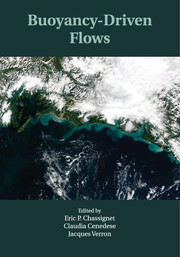Book contents
- Frontmatter
- Contents
- List of Contributors
- Introduction
- 1 Gravity currents – theory and laboratory experiments
- 2 Theory of oceanic buoyancy-driven flows
- 3 Buoyancy-forced circulation and downwelling in marginal seas
- 4 Buoyant coastal currents
- 5 Overflows and convectively driven flows
- 6 An ocean climate modeling perspective on buoyancy-driven flows
- 7 Buoyancy-driven currents in eddying ocean models
- 8 Atmospheric buoyancy-driven flows
- 9 Volcanic flows
- 10 Gravity flow on steep slope
- Index
- Plate section
- References
5 - Overflows and convectively driven flows
Published online by Cambridge University Press: 05 April 2012
- Frontmatter
- Contents
- List of Contributors
- Introduction
- 1 Gravity currents – theory and laboratory experiments
- 2 Theory of oceanic buoyancy-driven flows
- 3 Buoyancy-forced circulation and downwelling in marginal seas
- 4 Buoyant coastal currents
- 5 Overflows and convectively driven flows
- 6 An ocean climate modeling perspective on buoyancy-driven flows
- 7 Buoyancy-driven currents in eddying ocean models
- 8 Atmospheric buoyancy-driven flows
- 9 Volcanic flows
- 10 Gravity flow on steep slope
- Index
- Plate section
- References
Summary
Introduction to Overflows
What Are Dense Overflows?
Dense water formed in semi-enclosed seas often has to flow through narrow straits or down continental slopes before it reaches the open ocean. These regions of dense water flowing over topography are known as dense overflows. The dense water has been formed through a variety of processes including surface cooling, the addition of salt in the form of brine from freezing pack ice in high-latitude seas, and evaporation in enclosed subtropical seas. The dense overflows are regions of significant mixing, which modifies the temperature and salinity signal of the dense water. Many of the deep water-masses of the ocean originate in these overflows and have their properties set by the mixing that occurs therein. For example, the Nordic overflows occurring in gaps in the Greenland-Iceland-Scotland Ridge (e.g., the Denmark Straits and the Faroe Bank Channel) are the source of most of the North Atlantic Deep Water (NADW), whereas Antarctic Bottom Water (AABW) is replenished by dense overflows from the Weddell and Ross seas in the Antarctic. Together these two deep water-masses are responsible for most of the deep branches of the meridional overturning circulation (MOC). Other overflows, such as the Red Sea overflow and Mediterranean outflow, contribute to important saline waters at intermediate depths. The properties of the deep and intermediate water-masses covering much of the abyssal ocean are therefore determined to a large extent by the mixing that takes place in the overflow, and hence these localized mixing regions play a significant role in influencing the large-scale ocean circulation.
- Type
- Chapter
- Information
- Buoyancy-Driven Flows , pp. 203 - 239Publisher: Cambridge University PressPrint publication year: 2012
References
- 8
- Cited by



